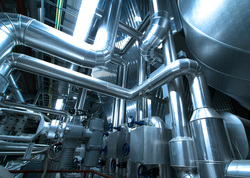
People don’t think much about the air they breathe. The walk in and out of buildings, only registering the difference if there is some kind of scent associated with it. Yet many public buildings, like universities and hospitals, have to carefully monitor their air for the amount of oxygen within it.
Enter the oxygen deficiency monitor.
The interface for oxygen deficiency monitoring equipment mounts on the wall, much like a temperature control, allowing for the user to manage the settings. However, instead of managing how the indoor climate feels, it manages how much oxygen is within the air.
An oxygen deficiency monitoring system gives building owners the ability to ensure sufficient oxygen levels for users, patrons, and employees. In cases where the oxygen levels go outside of the set parameters an alarm will go off to give an alert that something needs to be investigated.
As an optional bonus for oxygen deficiency monitoring equipment is a remote sensor. The remote sensor can be set apart from the main electronics for remote detection. An oxygen deficiency monitor with a remote sensor gives added reach to the typical detection setup.
In situations where an inert system isn’t viable, getting a portable oxygen deficiency monitor is a fine choice. However, a portable system may sacrifice necessary features, requiring investigating the options and user reviews pretty stringently.
When buying an oxygen deficiency monitor, portable or otherwise, make sure to get one that is constantly checking the oxygen levels. It doesn’t take long for a person in an oxygen deficient situation to encounter trouble: a swift alert is crucial. Some of these portable systems are used with headphones, alerting only the user, others can be audible to everyone in the area.
These systems come with a variety of variables that can affect not just the initial cost, but future maintenance costs. Some come with oxygen sensors that need to be replaced every year or two, others can last over five years. Some systems don’t react to temperature changes, others do. Understanding the pros and cons of a system before purchase will help you to get the oxygen deficiency monitor that is best for you.
Any environment where there is a possibility of gases replacing oxygen, such as a lab or medical facility, needs to have a monitoring system. It is fine to hope that no problems arise, resulting in an oxygen deficient scenario, but in cases where it does happen, you need the edge that an alarm provides.
Enter the oxygen deficiency monitor.
The interface for oxygen deficiency monitoring equipment mounts on the wall, much like a temperature control, allowing for the user to manage the settings. However, instead of managing how the indoor climate feels, it manages how much oxygen is within the air.
An oxygen deficiency monitoring system gives building owners the ability to ensure sufficient oxygen levels for users, patrons, and employees. In cases where the oxygen levels go outside of the set parameters an alarm will go off to give an alert that something needs to be investigated.
As an optional bonus for oxygen deficiency monitoring equipment is a remote sensor. The remote sensor can be set apart from the main electronics for remote detection. An oxygen deficiency monitor with a remote sensor gives added reach to the typical detection setup.
In situations where an inert system isn’t viable, getting a portable oxygen deficiency monitor is a fine choice. However, a portable system may sacrifice necessary features, requiring investigating the options and user reviews pretty stringently.
When buying an oxygen deficiency monitor, portable or otherwise, make sure to get one that is constantly checking the oxygen levels. It doesn’t take long for a person in an oxygen deficient situation to encounter trouble: a swift alert is crucial. Some of these portable systems are used with headphones, alerting only the user, others can be audible to everyone in the area.
These systems come with a variety of variables that can affect not just the initial cost, but future maintenance costs. Some come with oxygen sensors that need to be replaced every year or two, others can last over five years. Some systems don’t react to temperature changes, others do. Understanding the pros and cons of a system before purchase will help you to get the oxygen deficiency monitor that is best for you.
Any environment where there is a possibility of gases replacing oxygen, such as a lab or medical facility, needs to have a monitoring system. It is fine to hope that no problems arise, resulting in an oxygen deficient scenario, but in cases where it does happen, you need the edge that an alarm provides.

 RSS Feed
RSS Feed